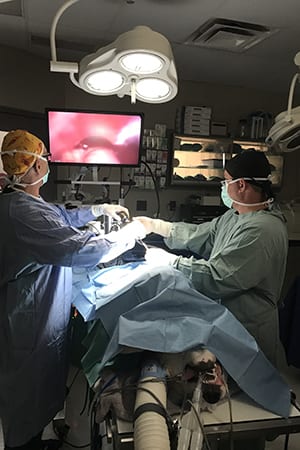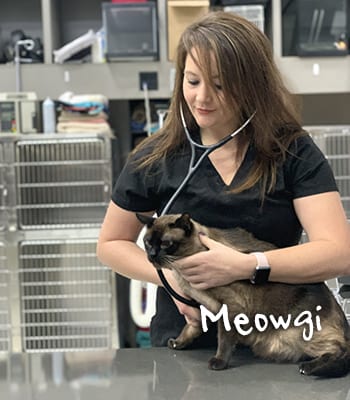Endoscopy and Laparoscopy Dog and Cat Surgery in Tulsa
At the Animal Emergency Center of Tulsa, we aim to not only care for your pet’s immediate needs, but plan for their recovery, too. Our veterinarian, Dr. Khris Keller is trained in both endoscopic and laparoscopic procedures. These dog and cat surgeries are a less invasive alternative to traditional open surgery. They involve two to three keyhole-sized incisions, in which a small camera (the endoscope) and the surgical instruments are inserted. This type of procedure cuts down tremendously on several risks associated with traditional surgery.

What is an Endoscope?
Laparoscopic dog and cat surgery is just one instance in which we use an endoscope. In fact, “endoscopy” is a broad term for any procedure using an endoscope. Different terms refer to the different body cavities in which we use the endoscope, such as laparoscopy (abdominal cavity), arthroscopy (joint space), and otoscopy (external and middle ear), among others. Laparoscopy is one of the most common endoscopic procedures.

When We Perform Endoscopic Dog and Cat Surgery
An endoscopic procedure is invaluable both in exploratory surgery and corrective dog and cat surgeries. Some of the common procedures we perform with an endoscope include:
Endoscopic procedures (using a flexible endoscope):
- Gastroscopy
- Endoscopic examination of the small intestine
- Colonoscopy
- Removal of foreign bodies in the gastrointestinal tract
- Laryngoscopy
- Tracheobronchoscopy
Laparoscopic procedures (using a rigid endoscope):
- Gastropexy
- Ovariectomy
- Cystoscopy
- Rhinoscopy
- Otoscopy
- Abdominal organ biopsy
Benefits of an Endoscopy
Using an endoscope offers significant benefits to both the patient and our team, including:
- Less invasive
- Reduced pain
- Shorter recovery time
- Smaller incisions
- Better visualization of internal structures due to the high-quality camera lens
Many emergency cases present with abdominal issues—whether an ingested foreign body, a known toxin, or excessive vomiting or diarrhea. Due to the benefits of the procedure to your pet, we perform an endoscopy or laparoscopy whenever possible.

